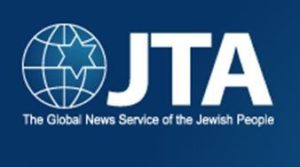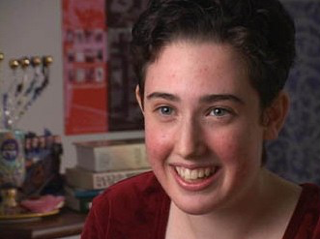
By E.B. Solomont

NEW YORK (JTA) — The newsletter sent out last month by Temple Israel of New Rochelle contained the usual sort of announcements, including a reminder about the synagogue’s upcoming Purim carnival, mazal tovs and condolences, and nformation about a social event at a local steakhouse.
But a small notice about a screening of the film “Hineini: Coming Out In a Jewish High School” reflected a quiet change at the Reform synagogue in suburban New York.

Scene from the film “Hineini: Coming Out In a Jewish High School,” which one suburban New York synagogue screened in an effort to be more welcoming to gay and lesbian Jews. (Hineini)
The screening is part of an overall push by Temple Israel to be more welcoming to gay and lesbian Jews. In recent months, the synagogue has edited its membership forms to accommodate diverse family structures, and it now advertises in the gay press and with gay advocacy groups. It also plans to train teachers to be sensitive to issues related to sexuality.
Prompted by the experience of a teenager in the community who was teased when he revealed his homosexuality, momentum built last year when the synagogue hired a new youth director who is openly gay.
“On some level, I kind of view myself as a poster child and that these kids and the adults need to see somebody in the community who fits the description,” said Barry Shainker, the youth director.
Shainker says that while changes are programmatic, the goal is to make such inclusiveness routine.
“Of course in some ways, our goal is to put ourselves out of a job,” he said. “In a few years this will be a no-brainer. What could be a 30-minute discussion at a board meeting becomes a 30-second vote in the future.”
Temple Israel is not alone: A recent conference in New York attracted a cadre of about 60 rabbis, educators and activists from across the denominational spectrum who shared “best practices” for becoming more welcoming to gay and lesbian Jews.
The conference, organized by Jewish Mosaic and the Institute for Judaism and Sexual Orientation at the Hebrew Union College-Jewish Institute of Religion, was part of the “Welcoming Synagogues Project,” which seeks to develop a model for inclusiveness to be implemented this summer by 10 pilot congregations.
“We’re trying to come up with a process that’s scalable,” said Joel Kushner, director of the Institute for Judaism and Sexual Orientation. A similar program took place March 1-2 in Los Angeles.
“There isn’t going to be one size fits all,” he said.
Findings from the 2009 Synagogue Survey on Diversity and LGBT Inclusion, presented at the New York conference, underscored what Kushner described as a need for congregations to be more welcoming. The survey found that 73 percent of the 760 rabbis polled think their congregation is welcoming to gay and lesbian Jews, although only 33 percent of the 997 synagogues that responded offer programs aimed specifically at gays and lesbians.
In general, Antenson noted with regret, the Jewish community has not been at the forefront of welcoming gays and lesbians into synagogue life.
Antenson, a lay leader and member of the marriage equality, membership and interfaith committees at B’nai Jeshurun, said that when he told fellow congregants about his partner, “I never got a reaction.”
Half of the members of the marriage equality chevra are straight and at B’nai Jeshurun, it is common to celebrate the anniversary of a gay couple, or to see a gay or lesbian couple celebrating an aufruf.
“It’s public evidence that we welcome gays and lesbians, and they are full members of the congregation,” Antenson said.
But according to Aaron Weininger, a second-year rabbinical student at the Jewish Theological Seminary, a change in cultural assumptions must accompany concrete actions.
“There are so many ways to engage the issues,” he said, citing films such as “Hineini” and programs like LGBT Shabbat dinners. “It is not ‘either-or,’ it’s ‘and.’ “
While Weininger noted there is no “one size fits all” model, he said synagogues should be asking whether they are engaging all members of the community.
“Because LGBT Jews have been marginalized and alienated for so long, there does need to be a certain level of awareness,” he said. “The more messages our synagogues send that are pro- inclusion, the more younger people coming out and identifying as LGBT feel safe.”
Still, he and others noted, a shift in attitude in Conservative congregations is linked to the movement’s policies regarding gay rabbis and cantors.
Rabbi Morris Allen of Beth Jacob Congregation in Mendota Heights, Minn., said his congregation was ahead of the curve and had been since the mid-1990s, when the synagogue was asked to participate in a gay marriage ceremony.
“I think that the Conservative movement in its official capacity sort of caught up to what we’ve been doing,” said Allen, who served on the Rabbinical Assembly’s Committee on Human Sexuality in the early 1990s.
Allen said in lieu of programs targeting LGBT members, his congregation has adopted a welcoming mind-set.
“We didn’t make a special gay slot on our board,” he said.
Gay members serve on the board because they are involved and supportive of the synagogue.
“For many years, people did not feel they could talk about the core of who they were,” Allen said. “I think all we’ve done is open the door and allow people to walk in.”